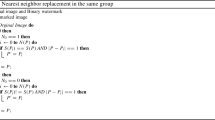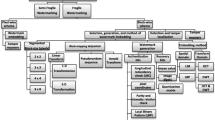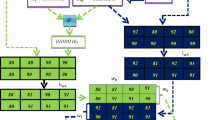Abstract
Fragile digital watermarking is mainly used for digital content authentication, which is of great significance for protecting information security. A novel fragile spatial watermarking scheme based on prime number distribution theory is proposed in this paper. Firstly, 54 approximate pixel sets are constructed according to the prime number distribution in [0,255]. Secondly, the embedding of watermark information is achieved by pixel replacement in the approximate pixel set, while the MD5 hashing algorithm is used in the embedding process to ensure the security of the scheme. The experimental results show that the proposed watermarking scheme has better performance compared with the existing methods. It is not only robust to common image processing operations such as additive noise, rotation, sharpening and etc., but also has good invisibility, fragility, high capacity and low computational cost.












Similar content being viewed by others
References
Tirkel, Andrew Z., Ron G. van Schyndel, and C. F. Osborne. "A two-dimensional digital watermark." Dicta. Vol. 95. No. 7. 1995.
K. Tanaka, Y. Nakamura, K. Matsui, Proc. IEEE ILCOM Int. Conf, 1990, p. 216.
Celik MU, Sharma G, Tekalp AM et al (2005) Lossless generalized-LSB embedding [J]. IEEE Trans Image Process 14(2):253–266
Song W, Hou J, Li Z et al (2011) Chaotic system and QR factorization based robust digital image watermarking algorithm[J]. J Cent S Univ Technol 18(1):116–124
Abdulla AA, Sellahewa H, Jassim SA (2014) Steganography based on pixel intensity value decomposition[C]//Mobile multimedia/image processing, security, and applications 2014. International Society for Optics and Photonics 9120:912005
Abdulla, Anwer A. Exploiting similarities between secret and cover images for improved embedding efficiency and security in digital steganography. 2015.
Abraham J, Paul V (2016) An imperceptible spatial domain color image watermarking scheme[J]. Journal of King Saud University Computer & Information Sciences S1319157816301483
Malik A, Sikka G, Verma HK (2017) Image interpolation based high capacity reversible data hiding scheme[J]. Multimed Tools Appl
Bravo-Solorio S, Calderon F, Li CT et al (2017) Fast fragile watermark embedding and iterative mechanism with high self-restoration performance[J]. Digital Signal Processing 73:83–92
Kristyan S (2017) On the statistical distribution of prime numbers: a view from where the distribution of prime numbers are not erratic[C]//AIP conference proceedings. AIP Publishing LLC 1863(1):560013
Wenqing L, Zhang L (2018) Geomatics F O, et al. A DFT-Based Zero-Watermarking Agorithm for Vector Geodata, Journal of Geomatics Science and Technology
Molina-Garcia J, Garcia-Salgado BP, Ponomaryov V et al (2019) An effective fragile watermarking scheme for color image tampering detection and self-recovery[J]. Signal Processing Image Communication 81
Fouque PA, Tibouchi M (2019) Close to uniform prime number generation with fewer random bits[J]. IEEE Trans Inf Theory 65(2):1307–1317
Aditya BP, Avaneesh UGK, Adithya K et al (2019) Invisible semi-fragile watermarking and steganography of digital videos for content authentication and data hiding[J]. International Journal of Image and Graphics
Hemida O, Huo Y, He H et al (2019) A restorable fragile watermarking scheme with superior localization for both natural and text images[J]. Multimed Tools Appl 78(9):12373–12403
Zichen L, Peifei S, Haiyang D. Semi-Fragile Watermarking Algorithm Based on DWT with Tamper Localization[J]. journal of information security research, 2019
Su Q, Liu D, Yuan Z et al (2019) New rapid and robust color image watermarking technique in spatial domain[J]. IEEE Access 7:30398–30409
Hamidi M, Haziti M E, Cherifi H, et al. Hybrid blind robust image watermarking technique based on DFT-DCT and Arnold transform. 2019.
Li Z, Song P (2019) Ding H. Semi-Fragile Watermarking Algorithm Based on DWT with Tamper Localization, Journal of Information Security Research
akhmawati L, Wiryanto, Rochmawati N, et al. Fragile Watermarking Technique using a Linear Block Mapping for Document Image Authentication with Recovery Capability[C]// International Seminar on Research of Information Technology and Intelligent Systems.0.
Tian L, Dai H, Li C (2020) A semi-fragile video watermarking algorithm based on chromatic residual DCT[J]. Multimed Tools Appl:1–21
Machado JT, Lopes AM (2020) Multidimensional scaling and visualization of patterns in prime numbers[J]. Commun Nonlinear Sci Numer Simul 83:105128
Cotti G. Coalescence phenomenon of quantum Cohomology of Grassmannians and the distribution of prime numbers[J]. Int Math Res Not, 2020.
Barbarani V (2020) A quantum model of the distribution of prime numbers and the Riemann hypothesis[J]. Int J Theor Phys 231
Yuan Z, Liu D, Zhang X et al (2020) New image blind watermarking method based on two-dimensional discrete cosine transform[J]. Optik 204:164152
Ly M. Prime number function Fonction nombre premier[J]. 2020.
Richter F K. A new elementary proof of the Prime Number Theorem[J]. arXiv preprint arXiv:2002.03255, 2020.
Pihlaja J. The abstract prime number theorem for generalized progressions[J]. 2020.
An invisible DWT watermarking algorithm using noise removal with application to dermoscopic images[J]. Journal of Physics: Conference Series, 2021, 1730(1):012010 (9 pp).
Ma Z (1903) A survey on Newmann’s proof of the prime number theorem[C]//journal of physics: conference series. IOP Publishing 2021(1):012012
Barbarani V (2021) Combinatorial models of the distribution of prime numbers[J]. Mathematics 9(11):1224
Author information
Authors and Affiliations
Corresponding authors
Additional information
Publisher’s note
Springer Nature remains neutral with regard to jurisdictional claims in published maps and institutional affiliations.
Rights and permissions
About this article
Cite this article
Xia, Z., Zhang, W., Duan, H. et al. Fragile watermarking scheme in spatial domain based on prime number distribution theory. Multimed Tools Appl 81, 6477–6496 (2022). https://doi.org/10.1007/s11042-021-11704-3
Received:
Revised:
Accepted:
Published:
Issue Date:
DOI: https://doi.org/10.1007/s11042-021-11704-3




